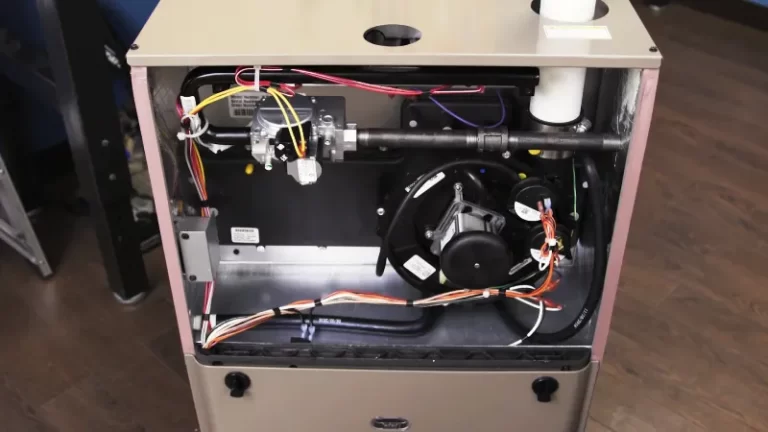Blomberg Refrigerator Problems and Solutions
Blomberg refrigerators are known for their innovative features and stylish designs. However, like any other appliance, they can experience problems from time to time. Regular maintenance and proper troubleshooting can help keep your Blomberg refrigerator running smoothly and avoid costly repairs.
In this article, we will discuss some of the common problems that Blomberg refrigerator owners may encounter and provide tips on how to resolve them. Whether you’re dealing with a cooling issue, leak, or error code, we hope this guide will help you get your Blomberg refrigerator back to working order.
You'll Learn About
Blomberg Refrigerator Problems
Blomberg refrigerators can experience various problems that can range from simple to complex issues. Some common problems include: the refrigerator not working properly, the temperature being too low, the door seal being soiled or worn out, the control panel not working correctly, error codes appearing, bottom light not functioning, and more.
To troubleshoot these problems, it is suggested to check if the refrigerator is properly plugged in, check the fuse, read the owner’s manual, and check the warranty. Some problems can be solved by adjusting the temperature or cleaning the door seal, while others may require professional assistance.
It is important to note that some customers have reported mixed experiences with Blomberg refrigerators, with some finding them to be of good quality, while others have reported negative experiences.
Problem 1: Not Cooling Properly
Blomberg refrigerators are designed to maintain optimal temperature for storing food and drinks, but sometimes the cooling system may not work as expected. There are several possible causes for this problem, which can result in warm air circulating inside the refrigerator or freezer. Let’s take a closer look at each one.
Possible causes
Thermostat Setting
One of the most common reasons for a Blomberg refrigerator not cooling properly is a faulty thermostat. If the thermostat is not set to the correct temperature, it can result in warm air circulating inside the refrigerator. To resolve this issue, simply adjust the thermostat to a colder setting and wait for a few hours to see if the temperature improves.
Dirty Condenser Coils
The condenser coils play an important role in the cooling process of your Blomberg refrigerator, and if they are dirty, it can lead to inefficient cooling. Over time, dust and debris can accumulate on the coils, reducing their ability to release heat from the refrigerant. To resolve this issue, clean the coils using a soft brush or vacuum, and make sure they are free of any obstructions.
Fan Not Functioning
Another possible cause of a Blomberg refrigerator not cooling properly is a faulty fan. If the fan is not functioning, it can reduce the airflow inside the refrigerator, causing warm air to circulate. To resolve this issue, check if the fan is running and replace it if it is not.
Troubleshooting steps To resolve the issue of a Blomberg refrigerator not cooling properly, follow these troubleshooting steps:
- Check the thermostat setting and adjust it to a colder setting if necessary.
- Clean the condenser coils to remove any dirt or debris that may be affecting the cooling process.
- Verify that the fan is functioning and replace it if it is not.
- If the problem persists, contact a professional for further assistance.
In conclusion, if your Blomberg refrigerator is not cooling properly, there are several possible causes and troubleshooting steps you can follow to resolve the issue. Whether it’s adjusting the thermostat, cleaning the condenser coils, or replacing a faulty fan, taking care of these issues can help keep your Blomberg refrigerator running smoothly and efficiently.
Problem 2: Temperature Fluctuations
Possible causes
Dirty Evaporator Coils
The evaporator coils are responsible for absorbing heat from the interior of the refrigerator and expelling it to the outside. If these coils are dirty, they will not be able to function properly and the temperature inside the refrigerator will fluctuate.
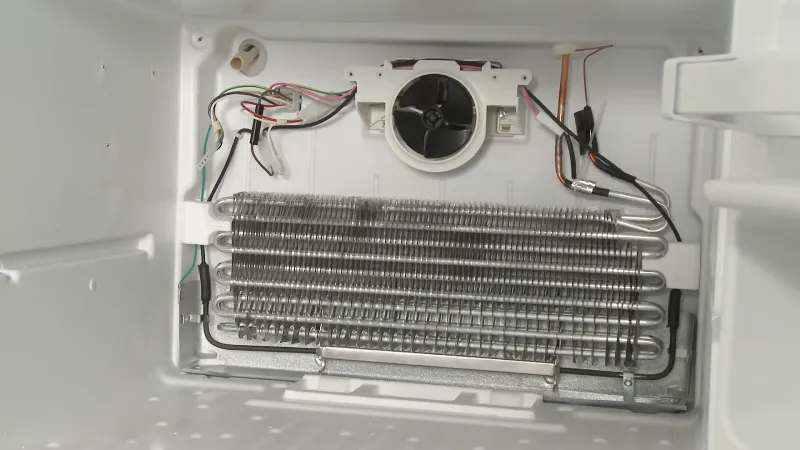
Door Not Sealing Properly
If the door seal is damaged or worn out, cold air will escape and warm air will enter the refrigerator. This can cause temperature fluctuations inside the refrigerator.
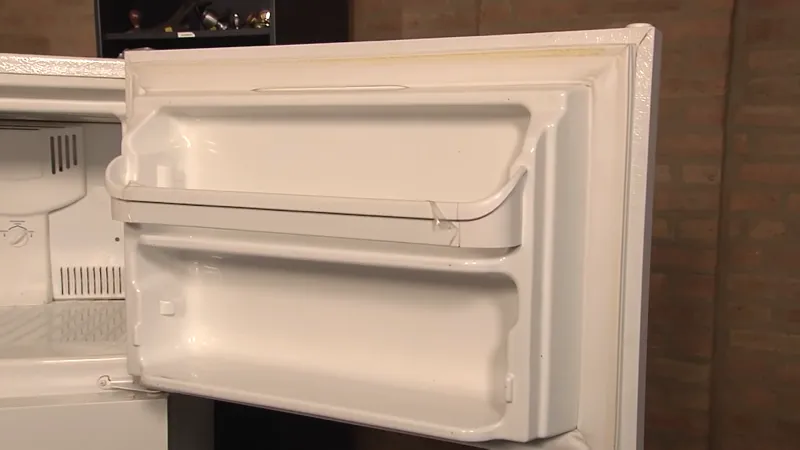
Clogged Defrost Drain
The defrost drain is responsible for removing any excess moisture that is produced during the defrost cycle. If the drain becomes clogged, water will accumulate and cause temperature fluctuations.
Troubleshooting steps
Clean the Evaporator Coils
Use a coil cleaning solution to clean the evaporator coils. Make sure to turn off the refrigerator and unplug it before you start cleaning.
Check the Door Seal
Check the door seal for any signs of damage or wear. If the door seal is damaged, replace it.
Clear the Defrost Drain
Use a turkey baster to clear any blockages in the defrost drain.
If your Blomberg refrigerator is experiencing temperature fluctuations, it is important to diagnose the issue and resolve it as soon as possible. A malfunctioning refrigerator can not only result in spoilage of food but can also lead to a higher energy bill. Regular maintenance, such as cleaning the evaporator coils and checking the door seal, can help prevent these types of problems from occurring.
Problem 3: Noisy Operation
Loose or Damaged Fan Blades
One of the common causes of a noisy Blomberg refrigerator is loose or damaged fan blades. The fan blades are responsible for circulating air within the refrigerator, and if they are loose or damaged, they can create a rattling or scraping sound.
Worn Out Bearings
Another possible cause of a noisy Blomberg refrigerator is worn out bearings. Bearings are used to support the moving parts of the fan, and if they are worn out, they can create a grinding or rubbing noise.
Compressor Issues
A faulty compressor can also cause a noisy operation in your Blomberg refrigerator. The compressor is responsible for pumping refrigerant through the refrigeration system, and if it is not working properly, it can create a loud humming or buzzing sound.
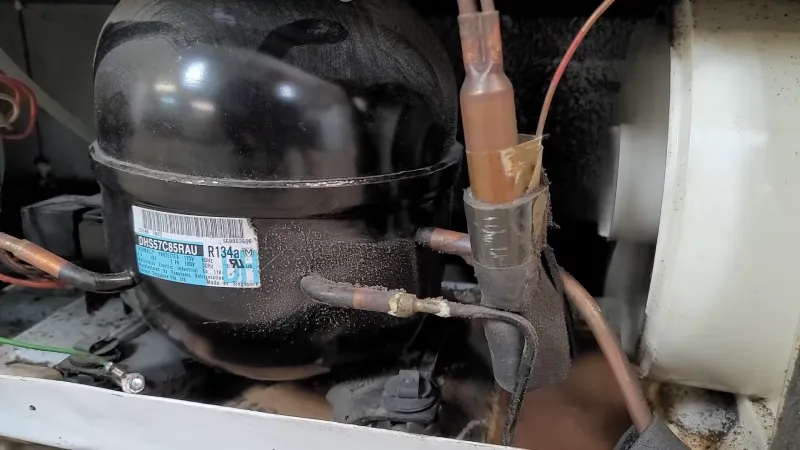
Troubleshooting Steps
Check the Fan Blades
If you hear a rattling or scraping sound, check the fan blades for any signs of damage or looseness. If the blades are damaged, replace them, and if they are loose, tighten them.
Check the Bearings
If you hear a grinding or rubbing noise, check the bearings for any signs of wear. If the bearings are worn out, replace them.
Check the Compressor
If you hear a loud humming or buzzing sound, check the compressor for any signs of damage or malfunctions. If the compressor is damaged, have it repaired or replaced by a professional.
A noisy Blomberg refrigerator can be caused by a number of factors, including loose or damaged fan blades, worn out bearings, and compressor issues. To troubleshoot these problems, it is important to carefully inspect the fan, bearings, and compressor and take appropriate action as needed.
Problem 4: Leaking Water
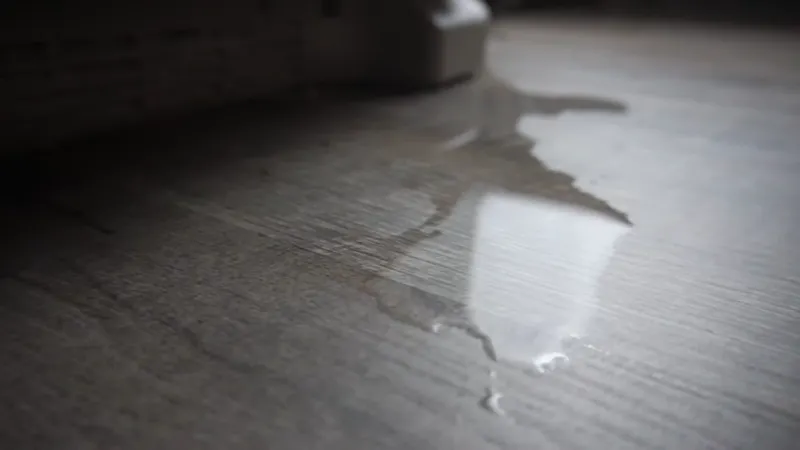
Clogged Defrost Drain
One of the most common causes of water leaks in refrigerators is a clogged defrost drain. The defrost drain is responsible for carrying excess water generated during the defrost cycle away from the unit. If the drain becomes clogged, water can build up and overflow, leading to leaks.
Broken or Leaky Water Line
Another possible cause of water leaks is a broken or leaky water line. The water line is responsible for supplying water to the ice maker or dispenser. If the line becomes damaged or leaks, water can seep out and cause puddles on the floor.
Overflowing Ice Maker
An overflowing ice maker can also cause water leaks in a Blomberg refrigerator. If the ice maker produces too much ice and the ice tray becomes full, water can overflow and leak onto the floor.
Troubleshooting steps
Check the Defrost Drain
If you suspect that a clogged defrost drain is causing your Blomberg refrigerator to leak water, you can start by checking the drain. Locate the drain and make sure it’s not clogged with debris. If it is, use a clean, stiff brush to clear it.
Check the Water Line
If you suspect that a broken or leaky water line is causing your Blomberg refrigerator to leak water, you can check the line for any visible signs of damage or leaks. If you find any, you may need to replace the water line.
Check the Ice Maker
If you suspect that an overflowing ice maker is causing your Blomberg refrigerator to leak water, you can start by checking the ice maker. Make sure that the ice tray is not overfilled. If it is, remove some of the ice and let the remaining ice melt.
Then, turn off the ice maker and allow it to reset.
Problem 5: Control Panel Not Working
There are several reasons why a Blomberg refrigerator’s control panel might not work properly. Some of the most common causes include:
Circuit Board Failure
The circuit board is the central component of the control panel, and it is responsible for communicating with the various parts of the refrigerator and controlling their functions. If the circuit board fails, the control panel will not work properly.
Power Outage or Surge
A power outage or surge can cause the circuit board to malfunction, leading to control panel issues. This can also cause other parts of the refrigerator to fail.
- User error: Sometimes, control panel problems can be caused by user error, such as incorrect settings or improperly connecting the control panel to the refrigerator.
Troubleshooting steps
If you are having issues with your Blomberg refrigerator’s control panel, here are some steps you can take to troubleshoot the problem:
Check the Power Source
Make sure the refrigerator is properly plugged in and that there is power to the outlet. If the outlet is not working, try plugging the refrigerator into another outlet.
Check the Circuit Board
If you suspect that the circuit board is the cause of the control panel problem, you can try resetting it. To reset the circuit board, unplug the refrigerator for a few minutes and then plug it back in.
Consult the Owner’s Manual
The owner’s manual for your Blomberg refrigerator will contain information about how to troubleshoot common control panel issues. Make sure to review the manual for specific troubleshooting tips for your model.
Contact Customer Service
If you are unable to resolve the control panel problem on your own, it may be necessary to contact Blomberg customer service for further assistance. They can provide additional troubleshooting tips and help you determine if a repair or replacement is necessary.
Problem 6: Door Not Closing Properly
Possible causes
Misaligned Hinges
Over time, the hinges on your Blomberg refrigerator door may become misaligned, making it difficult for the door to close properly. This can be due to normal wear and tear, or from a force being applied to the door.
Damaged Door Gasket
The door gasket, also known as the seal, is responsible for keeping the cool air inside the refrigerator. If it becomes damaged or worn out, it will not form a tight seal around the door, causing it to not close properly.
- Warped or bent door: A warped or bent door can prevent the door from closing properly and can be caused by excessive force being applied to the door, or due to a manufacturing defect.
Troubleshooting steps
Check the Hinges
Inspect the hinges to see if they are misaligned. If they are, they may need to be replaced or realigned.
Inspect the Door Gasket
Check the door gasket to see if it is damaged or worn out. If it is, it will need to be replaced.
Check the Door
Inspect the door to see if it is warped or bent. If it is, it may need to be replaced.
In conclusion, a Blomberg refrigerator door not closing properly can be caused by a variety of factors, including misaligned hinges, a damaged door gasket, or a warped or bent door. If you are having trouble with your Blomberg refrigerator door, it is recommended to troubleshoot the problem by checking the hinges, door gasket, and door. If the problem persists, it may be necessary to seek the help of a professional repair technician.
Problem 7: Error Codes
Overview of Common Error Codes
Error codes are diagnostic messages that appear on the control panel of Blomberg refrigerators. They indicate a specific problem that requires attention.
Some of the common error codes on Blomberg refrigerators include E1, E2, E3, and so on.
Possible Causes
Sensor Issues
Error codes may appear if the temperature sensors in the refrigerator are not functioning properly. They may be damaged or malfunctioning, leading to inaccurate temperature readings and error codes on the display.
Control Panel Failure
The control panel is the brain of the refrigerator and any failure in it can lead to the display of error codes. It could be a result of a power surge, a circuit board failure or a control panel issue.
Compressor Problems
Error codes may also appear if the compressor is not functioning properly. This may be due to a lack of refrigerant, a clogged condenser coil, or a faulty compressor motor.
Troubleshooting Steps
Check the User Manual
The user manual provides a comprehensive list of error codes and the possible causes. It is important to consult the manual to determine the specific error code and the cause of the problem.
Check the Sensors
If you suspect the sensors are the cause of the error code, unplug the refrigerator and check the sensors for any physical damage. Replace the damaged sensor if necessary.
Check the Control Panel
If the control panel is the cause of the error code, unplug the refrigerator and check the circuit board for any signs of physical damage. Replace the control panel if necessary.
Call for Professional Help
If the troubleshooting steps do not resolve the issue, it is best to call for professional help. A Blomberg certified technician can diagnose and repair the issue efficiently.
Problem 8: Frozen Food
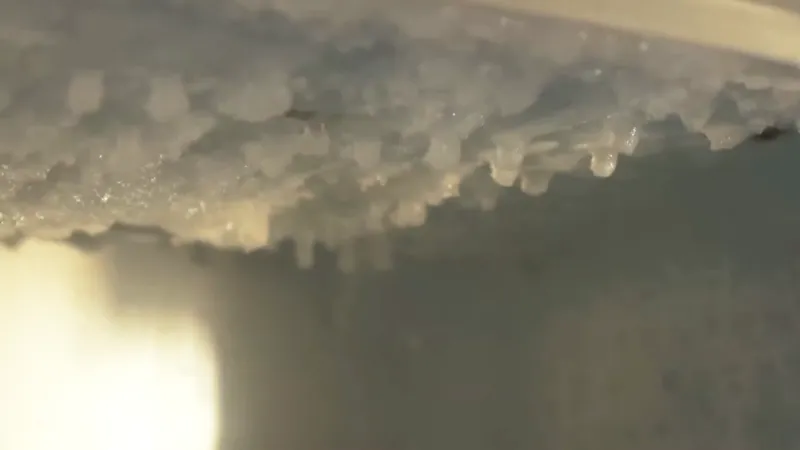
Possible Causes
Thermostat Setting
One of the most common reasons for frozen food in a refrigerator is a thermostat setting that is too low. If the temperature inside the refrigerator is set too low, it can cause the food inside to freeze.
Fan Not Circulating Air
Another common cause of frozen food in a refrigerator is a fan that is not functioning properly. The fan is responsible for circulating air inside the refrigerator, which helps to regulate the temperature and prevent freezing. If the fan is not working, the air inside the refrigerator can become stagnant and cause the food to freeze.
Dirty or Clogged Air Vents
Air vents are responsible for allowing air to circulate inside the refrigerator. If the air vents become clogged with dirt or debris, the air flow inside the refrigerator can become restricted, leading to stagnant air and frozen food.
Troubleshooting Steps
Check the Thermostat Setting
If you suspect that the thermostat setting may be the cause of frozen food, you can easily check and adjust the setting. Most refrigerators have a thermostat control located inside the refrigerator compartment or on the control panel.
Check the Fan
If the fan is not functioning properly, you may need to have it replaced by a professional. Before replacing the fan, however, you should check to make sure that it is not simply clogged with debris.
Clean the Air Vents
If you suspect that dirty or clogged air vents are causing the problem, you can easily clean them with a soft cloth and mild soap. If the air vents are severely clogged, you may need to have them replaced by a professional.
By following these troubleshooting steps, you can quickly and easily resolve the issue of frozen food in your Blomberg refrigerator and get your food back to its proper temperature.
Conclusion
Blomberg refrigerators, like all appliances, can encounter various problems from time to time. Some of the common issues include not cooling properly, temperature fluctuations, noisy operation, leaking water, control panel not working, door not closing properly, error codes, and frozen food.
Regular maintenance and troubleshooting can help prevent or fix these problems. By understanding the possible causes and troubleshooting steps, homeowners can save time and money, and keep their Blomberg refrigerator running smoothly.
However, it’s important to note that some issues may require professional repair or replacement. To ensure the longevity and performance of your Blomberg refrigerator, it’s advisable to follow the manufacturer’s guidelines and keep it in good working condition.

